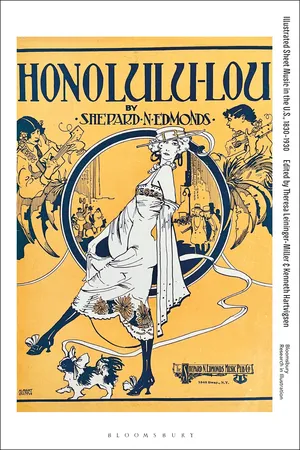
Illustrated Sheet Music in the U.S., 1830-1930
- English
- ePUB (mobile friendly)
- Available on iOS & Android
Illustrated Sheet Music in the U.S., 1830-1930
About this book
Illustrated sheet music was one of the most democratic forms of visual imagery in the U.S., owned by millions of Americans wooed by compelling lithographic covers, who displayed and performed compositions on home pianos. Advancements in printing technologies in the 19th century, together with an emergent commercial system that facilitated the publication and broad distribution of popular music, led to a surge of elaborately illustrated sheet music. This book features essays by cutting-edge scholars who analyze the remarkable images that persuaded U.S. citizens to purchase mass-produced compositions for both personal and social pleasure. With some songs selling millions of copies as printed musical scores, music publishers commissioned artists to draw every conceivable subject as promotional illustrations, including genre scenes, portraits, political and historical events, sentimental allegories, flowers, landscapes, commercial buildings, and maritime views. As ubiquitous and democratic material culture, this imagery affected ordinary people in far greater ways than unique objects, like paintings and sculpture, possibly could. The pictures, many in saturated color with bold graphics, still intrigue, amaze, and amuse viewers today with their originality, skill, and content. Rooted in visual analysis, topics in this collection include perennially significant themes: race, ethnicity, gender, sexuality, class, politics, war, patriotism, propaganda, religion, transportation, regional centers of production, technology, Reconstruction, romance, and comedy, as well as bodies of work by specific illustrators and lithographic firms. In recognizing the role that individuals have played in preserving these remarkable objects, it also features interviews with enthusiasts who own two of the largest private collections of sheet music in the U.S.
Frequently asked questions
- Essential is ideal for learners and professionals who enjoy exploring a wide range of subjects. Access the Essential Library with 800,000+ trusted titles and best-sellers across business, personal growth, and the humanities. Includes unlimited reading time and Standard Read Aloud voice.
- Complete: Perfect for advanced learners and researchers needing full, unrestricted access. Unlock 1.4M+ books across hundreds of subjects, including academic and specialized titles. The Complete Plan also includes advanced features like Premium Read Aloud and Research Assistant.
Please note we cannot support devices running on iOS 13 and Android 7 or earlier. Learn more about using the app.
Information
Table of contents
- Cover
- Half-Title Page
- Dedication
- Series page
- Title Page
- Contents
- List of Figures
- List of Contributors
- Foreword
- Acknowledgments
- Introduction
- Part I 1830–1900
- Chapter 1 Viral Pictures and Network Artistry in Antebellum Sheet Music Illustration
- Chapter 2 The Launch of a Marine Painter: Fitz Henry Lane’s Sheet Music Covers, 1833–41
- Chapter 3 Sounding the Spa: The Illustrated Sheet Music of Tourism in Antebellum America
- Chapter 4 Three Kings of Orient: The Magi and Slavery in an Illustrated American Christmas Carol from 1865
- Chapter 5 The Case of “Reconstruction! Grand March”: Horrif ying Pictures, Racial Hybridity, and the Visual Modalities of American Song
- Chapter 6 Racial Perceptions in the Sheet Music of Blind Tom and Blind Boone
- Chapter 7 Sheet Music Covers and the New Woman of 1895
- Intermission Interviews with Collectors
- Chapter 8 Interview with Kevin Hugh Lynch
- Chapter 9 Interview with Sandy Marrone
- Part II 1900–1930
- Chapter 10 Sheet Music, Blackf ace Minstrelsy, and the American Art Association of Paris, c. 1900
- Chapter 11 Education and Entertainment: The Louisiana Purchase Exposition in Sheet Music
- Chapter 12 Rust Belt Alley: Cleveland as Sheet Music Nexus (1890s–1930s)
- Chapter 13 Dance, Dining, and Urban Social Life in “Too Much Mustard” and Its Responses
- Chapter 14 “Are They Equal in the Eyes of the Law?”: African American Soldiers in First World War Illustrated Sheet Music
- Chapter 15 “There Were Giants in the Earth”: Sheet Music Monsters in the First World War
- Chapter 16 Settin g the Wes t to Music with Realistic Illustrations: A Case Study of Estelle Philleo’s Artistic Control
- Chapter 17 “If You Don’t Get It, Tain’t No Fault of Mine”: Illustrated Sheet Music by Albert Alexander Smi th in the U.S. and Paris, 1919–25
- Chapter 18 Alterity and Antiquarianism in the Illustrated Sheet Music of the Shriners
- Index
- Copyright